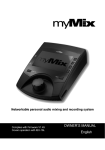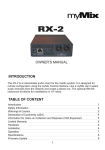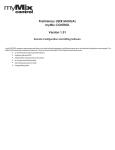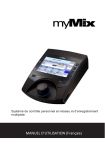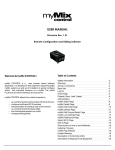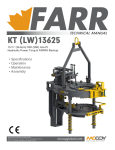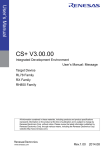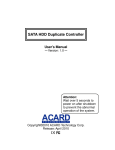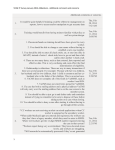Download myMix IEX-16L Owner`s manual
Transcript
IEX-16L 16 Channel Input Expander for myMix networkable personal audio monitoring and recording system Owner‘s Manual - ENGLISH V1-45 SAFETY INSTRUCTIONS I M P O R TA N T ! R e a d t h e f o l l o w i n g b e f o r e o p e r a t i n g I E X - 1 6 L 11. Keep these instructions in a safe place for future reference. Do not handle the power supply and other power cables with wet hands or on wet floor to avoid the risk of electric shock. 12. Unplug the IEX-16L unit during lightning storms. 3. Heed all warnings and follow all instructions. 13. 4. Do not use the IEX-16L unit near water, e.g. a bathtub, or swimming pool. 5. Clean only with dry cloth, and keep moisture away from the unit. 6. Do not block any ventilation openings. Install and use only in accordance with the manufacturer's instructions. Refer all servicing to qualified service personnel. Do not attempt to open the unit yourself. Servicing is required when the IEX-16L unit has been damaged in any way, liquid has been spilled or objects fallen into the unit, the unit has been exposed to water or moisture, does not operate normally, or has been dropped. 14. Exchanging the internal battery for memory should only be done by qualified personnel. Note that exchanging the battery will return the unit in factory default settings. Refer to your local dealer or the IEX-16L tech support if in doubt. 15. Do not place any objects filled with liquids such as cups and glasses on the unit. 16. Excessive sound pressure level from earphones, headphones and speakers can cause hearing damage and even hearing loss. 17. If anything drops into the media card slot, remove it after unplugging the power supply or Ethernet cable (when using Power over Ethernet), or consult your technical representative. 1. Read all safety and operating instruction before using IEX-16L. 2. 7. Do not install or use near any heat sources such as radiators, heat registers, stoves, or other apparatus (including power amplifiers) that produce heat. 8. Protect the power cord from being walked on or pinched. Replace the power supply it if the power cord or power supply shows signs of damage. 9. Only use attachments and accessories specified by the manufacturer. 10. The IEX-16L unit should only be used with a power supply as specified from the manufacturer. If the provided plug of the power supply does not fit in your outlet, consult your local dealer for the appropriate outlet. CAUTION Turn off all audio devices and speakers when connecting to IEX-16L. Refer to the owner's manual for each device. Use the correct cables and connect as specified. IEX-16L is a precision device. Handle it with care. If you notice any abnormality—such as smoke, odor, or noise—turn off IEX-16L immediately. Remove the AC power cord from the AC outlet. Confirm that the abnormality is no longer present. Consult your dealer for repair. Using IEX-16L in this condition is a fire and shock hazard. 2 If a foreign object or water gets inside IEX-16L, turn it off immediately. Remove the AC power supply from the AC outlet. Consult your dealer for repair. Using IEX16L in this condition is a fire and electrical shock hazard. If you plan not to use IEX-16L for a long period of time (such as when you are on vacation), remove the AC power supply from the AC outlet. Leaving IEX-16L connected is a fire hazard. WARNINGS Do not locate IEX-16L in a place subject to excessive heat or in direct sunlight. This could be a fire hazard. Do not place IEX-16L in a place subject to excessive humidity or dust. This could be a fire and electrical shock hazard. Connect the supplied AC power supply only to an AC outlet of the type stated in this Owner's Manual or as marked on the main unit. Failure to do so is a fire and electrical shock hazard. Do not place heavy objects on the power cord. A damaged power cord is a potential fire and electrical shock hazard. If the power cord is damaged (i.e., cut or a bare wire is exposed), ask your dealer for a replacement. Using IEX-16L in this condition is a fire and shock hazard. Hold the AC power supply when disconnecting from an AC outlet. Never pull the cord. Damaging the power cord in this way is a potential fire and electrical shock hazard. Do not place small metal objects on top of IEX-16L. Metal objects inside IEX-16L are a fire and electrical shock hazard. Do not block the IEX-16L ventilation holes. IEX-16L has ventilation holes at the front and the rear to prevent the internal temperature from rising. Blocked ventilation holes can damage the unit and are a fire hazard. Do not try to modify IEX-16L. This could be a fire and electrical shock hazard. Do not use IEX-16L in an environment outside of the temperature range between 5°C and 35°C (41°F and 95°F). Information for Users on Collection and Disposal of Old Equipment (EU) The symbol below on the products, packaging and/or accompanying documents means that used electrical and electronic products should not be mixed with general household waste. For proper treatment, recovery and recycling of old product please take them to applicable collection points, in accordance with your national legislation and the directives 2002/96/EC and 2006/66/EC.. By disposing of these products correctly, you will help to save valuable sources and prevent any potential negative effects on human health and the environment which could otherwise arise from inappropriate waste handling. For more information about collection and recycling of old products, please contact your local municipality, your waste disposal service or the point of sale where you purchased the item. Information for Users on Disposal of Old Equipment outside the EU The symbol left is only valid in the European Union. If you wish to discard these items, please contact your local authorities or dealer and ask for the correct method of disposal. 3 Declaration of Conformity (for USA) Model Number: Type of Equipment: Responsible Party: Address: Telephone Number : IEX-16L Input Expander for Professional Audio Recording and Mixing System MOVEK, LLC 6517 Navaho Trail, Edina, Minnesota, 55439, U.S.A. 1 (952) 657-7889 This device complies with Part 15 of the FCC Rules. Operation is subject to the following two conditions: (1) this device may not cause harmful interference, and (2) this device must accept any interference received, including interference that may cause undesired operation. NOTE: This equipment has been tested and found to comply with the limits for a Class B digital device, pursuant to part 15 of the FCC rules. These limits are designed to provide reasonable protection against harmful interference in a residential installation. This equipment generates uses and can radiate radio frequency energy and, if not installed and used in accordance with the instructions, may cause harmful interference to radio communications. However, there is no guarantee that interference will not occur in a particular installation. If this equipment does cause harmful interference to radio or television reception, which can be determined by turning the equipment off and on, the user is encouraged to try to correct the interference by one or more of the following measures: a) Reorient or relocate the receiving antenna. b) Increase the separation between the equipment and receiver. c) Connect the equipment into an outlet on a circuit different from that to which the receiver is connected. d) Consult the dealer or an experienced radio/TV technician for help. CAUTION Changes or modifications to this equipment not expressly approved by the manufacturer for compliance could void the user's authority to operate this equipment. LIMITED WARRANTY This MOVEK warranty applies only to products you purchased for your own use. This MOVEK limited warranty is available in others languages at . MOVEK warrants that each myMix product that you purchase is free from defects in materials and workmanship under normal use during the warranty period. The warranty period starts on the original date of purchased specified on your sales receipt or invoice unless MOVEK informs you otherwise in writing. During the warranty period of one year (or longer as required by law) MOVEK will provide warranty service without charge for parts and labor in case a defect in material or workmanship occurs. THIS WARRANTY IS YOUR EXCLUSIVE WARRANTY AND REPLACES ALL OTHER WARRANTIES OR CONDITIONS, EXPRESS OR IMPLIED, INCLUDING, BUT NOT LIMITED TO, THE IMPLIED WARRANTIES OR CONDITIONS OF MERCHANTABILITY AND FITNESS FOR A PARTICULAR PURPOSE. SOME STATES OR JURISDICTIONS DO NOT ALLOW THE EXCLUSION OF EXPRESS OR IMPLIED WARRANTIES, SO THE ABOVE EXCLUSION MAY NOT APPLY TO YOU. IN THAT EVENT, SUCH WARRANTIES APPLY ONLY TO THE EXTENT REQUIRED BY LAW AND ARE LIMITED IN DURATION TO THE WARRANTY PERIOD. NO WARRANTIES APPLY AFTER THAT PERIOD. SOME STATES OR JURISDICTIONS DO NOT ALLOW LIMITATIONS ON HOW LONG AN IMPLIED WARRANTY LASTS, SO THE ABOVE LIMITATION ON DURATION MAY NOT APPLY TO YOU. LIMITATION OF WARRANTY: UNDER NO CIRCUMSTANCES SHALL MOVEK, ITS SUPPLIERS, RESELLERS, OR SERVICE PROVIDERS BE LIABLE FOR ANY OF THE FOLLOWING EVEN IF INFORMED OF THEIR POSSIBILITY: 1) THIRD PARTY CLAIMS AGAINST YOU FOR DAMAGES; 2) LOSS OR DAMAGE TO YOUR DATA; OR 3) SPECIAL, INCIDENTAL, INDIRECT OR CONSEQUENTIAL DAMAGES, INCLUDING LOST PROFITS, BUSINESS REVENUE, GOODWILL OR ANTICIPATED SAVINGS. AS SOME STATES OR JURISDICTIONS DO NOT ALLOW THE EXCLUSION OR LIMITATION OF INCIDENTAL OR CONSEQUENTIAL DAMAGES, THE ABOVE LIMITATION OR EXCLUSION MAY NOT APPLY TO YOU. THIS WARRANTY GIVES YOU SPECIFIC LEGAL RIGHTS AND YOU MAY HAVE OTHER RIGHTS WHICH VARY FROM STATE TO STATE OR JURISDICTION TO JURISDICTION. YOU MAY ALSO HAVE OTHER RIGHTS UNDER APPLICABLE LAW OR WRITTEN AGREEMENT WITH MOVEK. NOTHING IN THIS WARRANTY AFFECTS STATUTORY RIGHTS, INCLUDING RIGHTS OF CONSUMERS UNDER NATIONAL LEGISLATION GOVERNING THE SALE OF CONSUMER GOODS THAT CANNOT BE WAIVED OR LIMITED BY CONTRACT. 4 TABLE OF CONTENTS SAFETY INSTRUCTIONS ............................................................................................................................2 WARNINGS ...................................................................................................................................................3 CAUTION ......................................................................................................................................................3 Information for Users on Collection and Disposal of Old Equipment (European Union) ..............................3 Information on Disposal in countries outside the European Union ...............................................................3 Declaration of Conformity (for USA)..............................................................................................................4 LIMITED WARRANTY ..................................................................................................................................4 TABLE OF CONTENTS ................................................................................................................................5 INTRODUCTION...........................................................................................................................................6 IMPORTANT NOTES ....................................................................................................................................6 INSTALLATION .............................................................................................................................................7 CONNECTIONS ........................................................................................................................................7 Audio Inputs ..............................................................................................................................................7 Network and Configuration Port ................................................................................................................7 Power Supply ............................................................................................................................................7 INTEGRATING INTO EXISTING SOUND SYSTEMS ..................................................................................8 Signals from a Mixing Console ..................................................................................................................8 Signal from a Microphone Splitter/Pre Amp ..............................................................................................9 Digtal Inputs- ADAT output from mixing console or soundcard ............................................................. 10 Digtal Inputs using a MADI to ADAT Interface ....................................................................................... 10 NETWORKING............................................................................................................................................ 11 Switch Requirements – Audio Channel Pairs – Network Configuration ................................................. 11 Network Examples .............................................................................................................................12-13 IEX-16L CONFIGURATION ........................................................................................................................ 14 Access, Lock, Factory Default................................................................................................................. 14 Input Mode .............................................................................................................................................. 14 Naming Inputs ......................................................................................................................................... 15 Input Gain ............................................................................................................................................... 15 SELECTING NETWORK SIGNALS WITH MYMIX ................................................................................16-17 SYSTEM EXAMPLES ............................................................................................................................18-19 UPDATING FIRMWARE ............................................................................................................................. 20 SPECIFICATIONS ...................................................................................................................................... 21 5 INTRODUCTION Thank you and congratulations for purchasing the IEX16L 16-channel input expander for myMix, the first networked personal mixer and multi-track recorder built for musicians. myMix has been designed with two main goals: to enable musicians to hear their music the way they want to hear it and to allow them to capture performances in multi-track recordings to optional SD or SDHC cards. myMix puts each musician in control of his or her own sound, with an intuitive user interface designed for creative people. The IEX-16L adds up to 16 channels to a myMix network from a single device. The IEX16L- is available in two versions. Both accept 2 x 8 analogue line level signals from sources such as mixing consoles, microphone preamps, or active splitter/preamps.The IEX16L-A has additional digital inputs in ADAT format. Audio signals sent into an IEX-16L can be configured as mono or stereo and can be named individually like the inputs on a myMix unit. They will appear on the network in the same way that inputs from myMix units appear. It is possible to have as many audio channels on the network as the number of multi-cast groups an Ethernet switch will support (e.g. 256). From all available network channels, whether the input is through a myMix device or the IEX- 16L, each myMix user can select up to 16 channels (8 pairs, dual mono or stereo) for his/her individual monitor mix. So not only the mix, already the channel selection can be made individually by each myMix user. This dramatically enhances the capabilities of the system, and allows flexibility for tailoring the monitoring options to the needs of each individual. Not only can each musician be in control of his personal mix, he can also decide what level of details he wants to see. For example, the drummer may want to have control of each microphone on his kit, but the other band members would rather have a stereo drum sub-mix. Conversely, the drummer may only want a stereo vocal sub-mix, but the vocalists want individual control of each vocal microphone. All of these signals can be injected onto the network (individual channels, multiple sub-mixes, etc) and be available for each individual musicians needs. Whether a 5 piece band or a 50 person orchestra, myMix allows every user to create his own personal monitor mix, and have access to a wide variety of signals that best suit his preferences. IMPORTANT NOTES with IEX-16L, myMix units require firmware version 1.33 or higher. ® The version IEX16L-A (with additional ADAT inputs) requires firmware 1.45. ® Check on www.mymixaudio.com for the latest available firmware. If your system operates on a lower revision than the latest published we recommend to update the firmware. ® All myMix devices that are on the same network must be on the same firmware version. ® Networks with more than 16 audio channels in total require the use of a managed switch that can handle multicast groups (see Switch Requirements and Network Configurations). ® To operate 6 ® Networks with less than 16 channels, regardless of the amount of devices on the network, can still be operated with standard unmanaged Fast Ethernet switches. This manual describes the functionality of firmware release V1.45. For updated versions of the owner‘s manual and more application details for myMix and IEX-16L, video tutorials and information in other languages, please visit: www.mymixaudio.com. INSTALLATION Front Panel 2 1 3 4 Rear Panel 24V 0.5A 5 6 1- Input Signal LEDs Channel 1-8 2- Input Signals LEDs Channel 9-16 3 -Configuration Port 4- Network Port 5- Connector for External Power Supply 6- Connector for Analog Input Signals Channel 9-16 7*- Input Selector Switch Channels 9-16 7* 8* 9* 10* 11* 12* 13 8* - LED for Digital Input Channels 9-16 9* - Optical Signal Input (ADAT Format) Channels 9-16 10* - Optical Signal Input (ADAT Format) Channels 1-8 11* - LED for Digital Input Channels 1-8 12* - Input Selector Switch Channels 1-8 13* - Connector for Analog Input Signals Channels 1-8 * only available on version IEX16L-A. When you unpack the IEX16L you should find the following items in the box: þ IEX-16L unit þ Power supply for IEX-16L with power plug þ Owner's manual with warranty information If any of these items are missing, contact your myMix dealer. The IEX-16L should be mounted in a 19" rack of suitable construction for its intended purpose. The four holes in the front panel of the IEX-16L support the full weight of the unit. Avoid to mount the IEX-16L next to devices that create excessive heat or strong radiating fields such as power amplifiers. Ensure that the IEX-16L has sufficient cooling. CONNECTIONS Audio Inputs Ch1 Ch2 Ch3 Ch4 Ch5 Hot 24 10 21 7 18 4 15 1 Cold 12 23 9 20 6 17 3 14 Grd 25 11 22 8 19 5 16 2 Pin Out DB25 Ch6 Ch7 Ch8 The IEX-16L has 16 analogue balanced line level inputs. They are grouped in blocks of eight channels on two DB25 female connectors [6 & 13]. The DB25 connectors use industry standard pin out for readily available audio snakes with XLR or TRS connectors. The version IEX16L-A is equipped with additional digital inputs in ADAT® format , 24-bit, 48kHz [9 & 10]. The input selector switches[7 & 12] toggle between analog or digital inputs for channels 1-8 and 9-16. The status LEDs [8 & 1] indicate the respective digital input. Network and Configuration Port Both ports are 100BASE-TX. While the network port [3] is used for the normal connection of the IEX-16L to the switch, the configuration port [4] is used to directly connect a myMix unit for the configuration of the IEX-16L. The configuration port does not carry any audio signals but has the lock capability. Power Supply [5] is the connection for the external power supply, 24V, 0.5A DC. The IEX-16L uses the same power supply that is shipped with myMix units. The IEX-16L doesn't have a power switch, so if you are not using it for an extended period of time it is recommended that you power the unit down by unplugging the power supply from the mains. 7 INTEGRATING INTO EXISTING SOUND SYSTEMS Depending on the application and personal preferences, there are many ways to integrate the IEX16L. The following two examples showing signal feeds from a console, and a splitter/microphone pre amp, should serve as a guideline. In some cases the perfect solution might consist of a mixture of individual signals (split or direct outputs) and sub-mixed signals from a mixing console (e.g. aux outputs) as inputs for the IEX-16L. Keep in mind that signals from local myMix units can be combined with signals from a single, or multiple, IEX-16L on the network. Signals from a mixing console To get sub mixes of individual signals (e.g. drums, vocals) onto the myMix system one usually uses auxiliary or group outputs from the console. Another option would be individual channel signals (e.g. lead vocalist) using direct outputs or, if the console doesn't feature individual direct outs, using the channel insert points (requires special cable, see below) to get the individual signal. The choice of where to pick a signal before it's sent to the myMix system for individual monitoring is crucial for overall system performance. Required cabling: Console Output Connector IEX16L cabling XLR male XLR female to DB25 ¼” TRS ¼” TRS to DB25 Unbalanced Insert Special Adaptor plus XLR to DB25 Tip Tip & Ring = Signal Ring Sleeve Pin 1= Ground Pin 2= Signal Sleeve= Ground Pin 3= Ground Special Adaptor TRS/XLR to use a console insert as direct output Input Gain Hi-Pass Filter Insert 1 Equalizer 2 3 4 Signal flow diagram showing four different options to get a signal for the IEX-16L 1: e.g. Direct Out, pre EQ, per Insert, or using the Insert as Direct Output 2: e.g. Aux Send, pre fader, pre EQ, post Insert 3: e.g. Aux Send, pre fader, post EQ 4: e.g. Aux Send post fader, or Direct Out post fader Notes: Pre Fader versus Post Fader signals for monitor use (Aux/Subgroup and Direct Outputs) A signal sent to the myMix monitor system “pre fader” means that the console output signal is unaltered by any level changes to the main mix. In most cases this is the preferred scenario. While subgroups always contain post fader signals, most auxiliary busses can be used as pre or post fader. Direct outputs on most professional analogue consoles can be available as pre or post fade. Inexpensive analogue console direct outputs are usually fixed, but occasionally have a switchable jumper option. Larger digital consoles usually feature fully configurable outputs, while many smaller digital consoles don't even have direct channel outs. In cases where pre fade direct outputs are not available, see use of Inserts as Direct Out with a special adapter (above), or getting signals from a mic splitter/pre amp (below). 8 Pre EQ versus Post EQ send Some consoles have switchable pre or post EQ sends for an aux signal. The channel EQ on the console is adjusted to provide the most pleasing sound for the house PA system, the venue, the audience, etc. In some cases, however, the EQ setting that works for the main mix is very different from the sound that is ideal for monitoring. An example of how this can be counter-productive is when the FOH channel EQ is setup to compensate for the acoustic response of a room, but the musicians are monitoring with in-ears that are not affected by the sound of the room. In other cases it may be useful to have all EQs and dynamics in the monitoring signal, especially in the case of a monitoring a multi-track recording session. Signals from a Microphone Splitter/Pre Amp The best guarantee of independence between monitor and main mix signals is provided when the signal is split right after the source and fed to the main mixing console and the myMix monitoring system separately. Thus any alteration of the signal is only audible within the respective system. Changes to main mix signals don't affect the monitor system signals, and vice versa. Usually there are two options available: Stagebox with built- in signal split Combined Signal Splitter/Pre Amp The multicore for the main mixing console has a stage box with built in split capability: in this case it's only necessary to use an external mic pre amp to get the signal to the IEX-16L. The multicore system has no split capability: in this case a mic splitter with built in mic preamps should be used. The direct signal is fed to the main console via the stagebox, while the split signal is fed to the IEX-16L for monitors. Multicore to Main Console Input Signal, e.g. microphone Multicore to Main Console Input Signal, e.g. microphone Microphone Splitter with integrated Pre-Amp Split Input Signal DB-25 to XLR female Microphone PreAmplifier with balanced outputs (TRS) IEX-16L Network Switch DB-25 to balanced 1/4" Jack (TRS) IEX-16L ... Network Switch ... The IEX16L is designed for line level signals, for microphone level signals you need an additional pre amp. The IEX16L has balanced inputs. If your signal is unbalanced, make sure the „cold“ pin is connected to ground. 9 INTEGRATING INTO EXISTING SOUND SYSTEMS-Digital Inputs IEX16L-A Digital Input from ADAT® outputs of a mixing console or sound card ADAT® Optical Output (8 channels) from digital console or soundcard Optical Cable - TOSLINK IEX-16L-A Network Switch The version IEX16L-A has in addition to the 2x 8 line level inputs 2 digital inputs in ADAT® format (24-bit, 48 kHz). This allows to get digital inputs from a digital console or a sound card directly into the myMix system. The ADAT® input card of the IEX16L-A has a sample rate converter. The clock for the myMix system is done internally within myMix, so no master clock needs to be supplied. Each ADAT® input is capable of 8 channels in 24-bit, 48kHz. As the inputs are switched in groups of 8, it is also possible to combine 8 analogue and 8 digital signals. The configuration and the operation of the signals is identical to any other signal within myMix. ... Digital Input using a MADI to ADAT® Interface Using third party MADI to ADAT® interface allows to feed up to 64 audio channels in 24-bit, 48kHz quality to the myMix system with a single cable. MADI MADI to ADAT Interface 8 x 8 ADAT In/Out Optical Cable - TOSLINK 4 IEX-16L-A Network Switch with GB Uplink 10 ... The MADI to ADAT® interface provides up to 8 signal groups of 8 channels each. One IEX16L-A can take two 8ch groups, so for the total of 64 channels, 4 IEX16L-A are used. A managed switch with a GB uplink (Cat6 cabling) is connected to another managed switch that distributes the signal to the myMix units. NETWORKING The myMix system uses an early (not the final) state of Ethernet AVB as its network protocol (e.g. audio transport according to IEEE-1722). The myMix network operates and is compatible with specifications of 100MB Fast Ethernet on Cat5 (or CAT5e) cabling. Readily available 100MB Fast Ethernet switches can be used to connect a myMix system. myMix devices (myMix, IEX-16L) have a 100MBps Ethernet interface. This bandwith allows for 8 x twochannels streams (=16 channels) of 24-bit, 48kHz audio in both directions. While the myMix and IEX16L are limited to these 8 pairs or 16 channels, the network can handle much more. To make more than 16 audio channels work, it is necessary to use a managed Fast Ethernet switch. Note: Keep in mind that until Ethernet AVB switches become available, it is necessary to keep the myMix network separate from other network traffic. For future use with AVB switches, myMix and IEX-16L have to be updated with an AVB compatible firmware version for the system. Switch Requirements - Audio Channel Pairs - Network Configuration The following subjects determine the type of switch or switches to configure a myMix system: The amount of network devices ( myMix and IEX-16L) determines the number of 100MBps ports on the switch(es). The amount of audio channel pairs: more than 8 pairs (max. 16 individual audio channels) requires a switch that supports IGMP snooping The amount of myMix units that should be powered via POE (Power-Over- Ethernet), POE enabled ports and POE budget of the switch. IEX-16L can only be powered via the external psu. The placement of the units, or the total system size might require more than one switch, in which case the Fast Ethernet switches need to provide Gigabit (1000BASE-TX) uplink ports. An audio channel pair can be configured as two dual mono or one stereo signal. If you only decide to select one channel of a pair for your mix screen, you are using up the capacity of two channels. This is because the pair is always traveling together on the network. Two adjacent inputs of the IEX-16L (1-2, 3-4, 5-6, …), like the two local inputs of a myMix unit are handled as one pair. You must place a signal which will be configured in stereo on an odd-even channel pair. For up to 8 audio channel pairs ( e.g. one IEX16L using all 16 inputs) a conventional Fast Ethernet switch is sufficient. If more than 16 audio channels (or more than 8 audio channel pairs) are used, then a managed switch that supports IGMP snooping is required. For tested switches and configuration examples see www.myMixaudio.com/support . Note: Each device in the myMix system can send and/or receive a maximum of 8 audio channel pairs. This can be accomplished in a 100MB Full Duplex Fast Ethernet (100BASE-TX) connection using a Cat5 or Cat5e cabling. Switches to connect myMix or IEX16L only need to handle 100MB Fast Ethernet. However, if you are considering using more than one switch in a system, a Gigabit (GB) port is required for an uplink connection to allow the transfer of all audio channels between the switches. The Gigabit (1000BASE-TX) requires CAT6 cabling. 11 Network Examples One myMix - one IEX-16L One myMix - one IEX-16L One IEX-16L can be connected directly via network port to one myMix. 16 audio channels can be mixed and recorded. Multiple myMix - one IEX-16L max 16 Channels 100MB Fast Ethernet Switch ... ... Multiple myMix (as many as can be connected to the switch) and one IEX16L can be used with a 100MB unmanaged Fast Ethernet switch for a maximum of 16 audio channels on the network. They can be any combination from myMix or IEX-16L, e.g. 16 channels from IEX-16L and no inputs from any myMix, or 12 channels (6 pairs) from IEX- 16L and 2 myMix using the local inputs (2 pairs= 4 channels)... Multiple myMix - one IEX-16L- more than 16 Channels 100MB Fast Ethernet Managed Switch with IGMP Snooping ... ... Multiple myMix and one IEX-16L on a managed switch for as many audio channels on the network as supported by the switch (e.g. 128). Example shows a switch with 8 POE ports connected to myMix and one extra100MB/s port for connecting to the IEX-16L. Multiple myMix - two IEX-16L- more than 16 Channels 100MB Fast Ethernet Managed Switch mit IGMP Snooping ... ... Multiple myMix (as many as can be connected to the switch) and two IEX16L on a managed switch for as many audio channels on the network as supported by the switch (e.g. 256). Example shows a switch with 8 POE ports connected to myMix and two extra ports without POE for IEX-16L. 100MB/s connection (CAT5e) 12 100MB/s Port System Examples Multiple myMix - two IEX-16L- two switches 100MB Fast Ethernet Managed Switch with 1GB Uplink Port 100MB Fast Ethernet Managed Switch with 1GB Uplink Port ... ... ... ... ... Both managed 100MB Fast Ethernet switches are connected through their 1GB uplink ports (using a CAT6 cable). Multiple myMix and one IEX-16L are connected to the 100MB Ethernet ports (optional with POE) of each switch. Both switches need to support IGMP snooping. Multiple myMix - multiple IEX-16L- multiple switches in star configuration Managed Gigabit Ethernet Switch 100MB Fast Ethernet Managed Switch with 1GB Uplink Port ... 100MB Fast Ethernet Managed Switch with 1GB Uplink Port ... ... ... ... ... Four 100MB Fast Ethernet Switches are connected in a start configuration to a central Gigabit Switch (1000BASE-TX). Each Fast Ethernet switch has one 1GB Uplink port, connected to the central Gigabit switch. Multiple myMixes and IEX-16L are connected to the 100MB Ethernet ports of the local switches. The GB connections are requiring a CAT6 cabling. 1GB/s connection (CAT6) 1GB/s Port 100MB/s connection (CAT5e) 100MB/s Port 13 IEX-16L CONFIGURATION Configuring the IEX-16L- with the exception of locking/unlocking- is possible from any myMix device on the network, or from a myMix unit that is connected to the CONFIG port of the IEX-16L. Note that the CONFIG port does not support any audio transmission. All settings in the IEX-16L (channel mode, naming, and gain) are stored within the actual unit, so if the unit is power cycled it will restore the settings to their last configuration. Access, Lock, Factory Default To show a list of all available remote devices on the myMix network, go to SETTINGS on any myMix on the network, scroll to Remote Devices and press the Encoder button. Each IEX-16L is shown with its name, MAC address, and current firmware version. RENAME, allows you to rename the IEX-16L as it should appear on the network. The LOCK/UNLOCK function is only available when connected to the CONFIG port. It is not possible to lock or unlock from a myMix over the network connection. When locked the IEX-16L can‘t be edited. Factory Defaults clear all current settings in the IEX-16L and puts all input channels to dual mono. IEX-16L (74:6B:82:00:A1:23)-v1.41 BACK IEX-16L (74:6B:82:00:A1:2A)-v1.41 RENAME Unit Name PROFILE 5 SD LOCK 6/28 FACTORY DEFAULT Input Mode Input-1:Dual Mono:Gain 0 BACK Input-2:Dual Mono:Gain 0 RENAME Input-3:Dual Mono:Gain 0 Input-4:Dual Mono:Gain 0 MODE Input-5:Dual Mono:Gain 0 SD GAIN Unit Name PROFILE 5 6/28 Selecting an IEX-16L from the list and pressing the myMix encoder button opens the configuration page of the IEX-16L. The softkey Mode toggles between the different input configurations. Dual Mono configures two independent mono channels, while Stereo assigns physically adjacent channels to a stereo pair where the odd channel number is left and the even channel number is right. Stereo pairs take the name of the odd numbered (or left) channel. Disable: disables an input pair from being active on the network. This function is useful when only a few inputs of the IEX-16L are used, or the overall network channel count has to be limited to 16 and other input sources are used as well. Note: when the IEX16L has been locked, it is still possible to look at the configuration from every myMix on the network, but not to change anything. Attempting to edit a locked IEX16L will trigger the message: „Locked“. 14 IEX-16L CONFIGURATION Naming Inputs Input-1:Dual Mono:Gain 0 CANCEL Input-2:Dual Mono:Gain 0 CHANGE CASE Input-3:Dual Input Mono:Gain 0 Input-4:Dual Mono:Gain 0 CLEAR Input-5:Dual Mono:Gain 0 SD SAVE Unit Name PROFILE 5 6/28 Pressing the softkey Name allows the naming of each input channel on the IEX-16L. Use the jog wheel to scroll through characters A-Z, space, and numbers 0 – 9. When you have selected the desired character, space, or number, push the jog wheel to move the cursor forward. Change Case allows to select between upper and lower case letters. CLEAR removes the currently selected letter and moves the cursor back. Press SAVE when done. Note: myMix remembers every channel it has seen on the network once in the current profile. New channels (= new channel name) on the network are automatically detected and displayed on the mix screen - until the maximum of 8 audio pairs (16 mono channels) is reached. Renaming a channel makes it appear new in the network. So be aware when you rename inputs that the settings stored go per channel name and not per physical input. If you e.g. change input 1 of an IEx16-L that was called „Lead Guitar“ to „Guitar“, this is seen as a new signal on the system. Settings were stored for the signal called „Lead Guitar“, the signal „Guitar“ will show up as new, with „zero mix““ settings (= zero volume, pan center, no effects). Input Gain Input-1:Dual Mono:Gain 0 BACK Input-2:Dual Mono:Gain 0 RENAME Input-3:Dual Mono:Gain 0 Input-4:Dual Mono:Gain 12 MODE Input-5:Dual Mono:Gain 0 SD GAIN Unit Name PROFILE 5 6/28 There is the possibility to add gain to each input of the IEX-16L using the softkey GAIN. The switch moves through three steps of digital gain: 0dB (default), +6dB, +12dB. If, for some reason, your analog signal going into the IEX-16L is weak, it can be increased in level here. Note: adding digital gain to a channel also increases the noise floor. If a signal appears to be weak, the preferred action would be to increase the level at the source. Only if that is not possible, this gain should be used - as a last resort. 15 Selecting Audio Channels for myMix IEX16L-1-Kick Drum IEX16L-1-Bass IEX16L-1-E-Guitar IEX16L-1-Keyboards Unit Name PROFILE 5 Each myMix can select its individual selection of up to 8 audio channel pairs (up to 16 audio channels) from all available channels on the network. On the status bar there is a counter that shows the total amount of network channels currently available (the figure behind the /) and the amount currently selected on the myMix (the figure before the /). Each myMix can select a maximum of 16 audio channels within 8 audio channel pairs. BACK IEX16L-1-Snare SD To select the audio signals you want to use for your local mix, go to SETTINGS and scroll to Remote Channel Selection. Open the list by pressing the encoder button. Here you can see all available signals on the network: from any IEX-16L as well as from any myMix device that uses its local inputs. Scroll to a channel and press the encoder button to toggle between “Selected” (green check), or “Deselected” (red X). 6/28 IEX16L-1-Input-15 BACK IEX16L-1-Input-16 myMix 5-Input-1 myMix 5-Click myMix 6-Ambience Mic Unit Name PROFILE 5 SD The channel selection is automatically stored in the current profile. It is recommended to create a new profile for a different scenario that has a different set of input signals as this will minimize the set-up time. myMix can store up to 20 different profiles. 14/28 Note: Because audio signals are streamed in pairs the channel counter will go up by two when you select a stereo channel, or a single mono signal. However, if you select the adjacent input to an already selected mono signal (e.g. input 4 from IEX16L, after you have selected input 3 already) the counter will not go up. 16 Example of Audio Channel Selection The following example is showing the signals of a myMix system and the individual selections from two musicians. Network Signal is the name of the signal. Source is listing where it is taken from: Direct Out or Aux Send from the mixing console, or direct from the source (e.g. via a secondary output or only connected to myMix). Input shows the input to the myMix network either via IEX-16L or a myMix unit. Audio channel pairs are shown in same color bars. Network Signal Source Input 1 Kick Drum Direct Out IEX 01 2 Snare Direct Out IEX 02 3 Submix Drums Left Aux Send IEX 03(S) 4 Submix Drums Right Aux Send IEX 04(S) 5 Bass Direct Out IEX 05 6 Saxophone Direct Out IEX 06 7 E-Guitar Direct Out IEX 07 8 Acoustic Guitar Direct Out IEX 08 9 Playback Left Direct Out IEX 09 (S) 10 Playback Right Direct Out IEX 10(S) 11 E-Guitar 2 direct myMix1-1(M) 12 Keyboards Left submix keys myMix2-1(S) 13 Keyboards Right submix keys myMix2-2(S) 14 Lead Vocals Direct Out IEX 11 15 Vocals 1 (Bass) Direct Out IEX 12 16 Vocals 2 (E-Guitar) Direct Out IEX 13 17 Vocals 3 (Keyboards) Direct Out IEX 14 18 Submix Vocals Left Aux Send IEX 15 19 Submix Vocals Right Aux Send IEX 16 20 Click (Drum Machine) direct myMix 3-1(M) 21 Ambience Mic direct myMix 4-1(M) 22 Playback Left direct myMix 5-1(S) 23 Playback Right direct myMix 5-2(S) (S) inputs configured stereo (DM) inputs dual mono (M) mono input The drummer‘s myMix DRUMMER Click IEX16-1 01 Kick Drum IEX16-1 03 Drums Mix IEX16-1 13 VocalsMix myMix 5 Playback IEX16-1 02 Snare IEX16-1 07 E-Guitar KEYBOARDER Keys SOLO MUTE 14/26 The drummer has selected 8 channels to create his mix. He has selected from 7 audio channels pairs, so the channel count is 14. The total amount of network channels shows 26 (16 from IEX-16L and 10 from the 5 myMix units). The lead singer‘s myMix IEX16-1 03 Drums Mix IEX16-1 07 E-Guitar IEX16-1 12 Vocal Bass IEX16-1 14 Vocal Keys IEX16-1 05 BASS SD Lead Singer Stage 2 BACK IEX16-1 11 Lead Vocal IEX16-1 13 Vocal Guitar KEYBOARDER Keys myMix 5 Playback myMix 4 Ambience One IEX-16L is located at the FOH console and receives a total of 16 input channels as Direct Outs or Aux Sends from the console. In addition five myMixes on stage are also taking input signals: E-Guitar-2 direct from the second output of a modeler, Keyboards direct from second output of the submixer, a drum machine (Click), one ambience microphone, and a file player with playbacks using the headphone outs to feed the signal in the mymix network. BACK SETTINGS DRUMMER PROFILE 5 SD # SOLO MUTE SETTINGS 16/26 The lead singer has selected 10 channels from 8 channel pairs. Note that he could still have selected the adjacent channels (e.g. IEX 06 -Saxophone, IEX 08 Acoustic Guitar) for the same channel count. Channel count for his unit is 16, the overall network has 26 audio channels. 17 SYSTEM EXAMPLES One IEX-16L with inputs from the mixing console # Network Signal Source Input 1 Kick Drum Direct Out IEX 01 2 Snare Direct Out IEX 02 3 Submix Drums Left Aux Send IEX 03(S) 4 Submix Drums Right Aux Send IEX 04(S) 5 Bass Direct Out IEX 05 6 Saxophone Direct Out IEX 06 7 E-Guitar Direct Out IEX 07 8 Acoustic Guitar Direct Out IEX 08 9 Keyboards Left Direct Out IEX 09(S) 10 Keyboards Right Direct Out IEX 10(S) 11 Lead Vocals Direct Out IEX 11 12 Vocals 1 (Bass) Direct Out IEX 12 13 Vocals 2 (E-Guitar) Direct Out IEX 13 14 Vocals 3 (Keyboards) Direct Out IEX 14 15 Submix Vocals Left Aux Send IEX 15 16 Submix Vocals Right Aux Send IEX 16 17 Click (Drum Machine) Left myMix (keys) Input 1(S) 18 Click (Drum Machine) Right myMix (keys) Input 2(S) Network signals are shown in audio channel pairs (same color) (S): Two audio channels linked for stereo signal 18 All signals picked up with a DI-Box or microphone are sent via the multi-core cable to the main console. 12 signals are fed from the direct outputs, four via aux send to the IEX-16L. The keyboardist is using the two local inputs of his myMix for a drum machine (click), which is not needed for the main console, but available in the myMix network for monitoring The six musicians can all select their individual selection of up to 16 channels (8 audio channel pairs) to create their individual mix. The selected channels are recorded as individual tracks when recorded to a SD/SDHC card. For a total of 18 channels a managed switch (IGMP snooping) needs to be used. If inputs 15/16 of the IEX16 were not used (disabled) the system can be operated using a simple unmanaged Ethernet switch. SYSTEM EXAMPLES Two IEX-16L with inputs from mic splitters and mixing console Stagebox not all network connections to myMix shown # 01 02 03 04 05 06 07 08 09 10 11 12 13 14 15 16 17 18 19 20 21 22 23 24 25 26 27 28 29 30 31 32 33 34 35 Network Signal Kick Drum Snare HiHat Tom 1 Tom 2 Tom 3 Overhead 1 Overhead 2 Baritone Trombone 1 Trombone 2 Trumpet 1 Trumpet 2 Trumpet 3 Saxophone 1 Saxophone 2 Saxophone 3 Clarinet 1 Clarinet 2 Vocal 1 Vocal 2 Vocal 3 Vocal 4 Keyboard Left Keyboard Right Bass E-Guitar SubMix Drums-L Submix Drums-R Submix Brass Submix Woodwinds Submix Rhythm-L Submix Rhythm -R Submix Vocals-L Submix Vocals R Source Splitter-1-01 Splitter-1-02 Splitter-1-03 Splitter-1-04 Splitter-1-05 Splitter-1-06 Splitter-1-07 Splitter-1-08 Splitter-2-01 Splitter-2-02 Splitter-2-03 Splitter-2-04 Splitter-2-05 Splitter-2-06 Splitter-2-07 Splitter-2-08 Splitter-3-01 Splitter-3-02 Splitter-3-03 Splitter-3-04 Splitter-3-05 Splitter-3-06 Splitter-3-07 Local Split Local Split Local Split Local Split Aux Send Aux Send Aux Send Aux Send Aux Send Aux Send Aux Send Aux Send Input IEX-1-01 IEX-1-02 IEX-1-03 IEX-1-04 IEX-1-05 IEX-1-06 IEX-1-07(S) IEX-1-08(S) IEX-1-09 IEX-1-10 IEX-1-11 IEX-1-12 IEX-1-13 IEX-1-14 IEX-1-15 IEX-1-16 IEX-2-01 IEX-2-02 IEX-2-03 IEX-2-04 IEX-2-05 IEX-2-06 IEX-2-07 myMix1(S) myMix1(S) myMix 2 myMix 2 IEX-2-09(S) IEX-2-10(S) IEX-2-11 IEX-2-12 IEX-2-13(S) IEX-2-14(S) IEX-2-15(S) IEX-2-16(S) All signals are picked up with DI box or microphone and run via multicore to the main console. 23 signals are split with a mic splitter/pre amp on stage and fed to the IEX-16L. Keyboards, bass and guitar are split locally (second output or link out from DI box) and fed to the local inputs of two myMix units. In addition two mono and three stereo sub mixes are sent from the console via multicore to the second IEX-16L. Each musician can pick between individual channels and submixes to create the individual mix. While the drummer might select all drum mics individually (8 channels) he selects submixes for vocals brass and woodwinds. The vocalists might want all vocal mics separately but a submix of the drums and the other instruments. This system needs a managed switch with IGMP snooping. To support 19 myMix units with POE, it might be simpler using two switches with 8 and 12 POE ports that are connected with a 1GB uplink (see Network System Examples page 12). 19 UPDATING FIRMWARE To operate with IEX-16L, myMix requires a firmware version of V1.33 or higher, IEX16L-A requires V1.45 or higher. To operate with myMix CONTROL all devices require 1.51 or higher. All myMix devices on a network shall always be on the same firmware rev. Check on www.mymixaudio.com for the latest firmware updates. Use the external psu for a firmware update. Don‘t connect myMix or the IEX-16L to a switch. The firmware update requires a temporarily free, in myMix formatted SD /SDHC card compliant to SDA 2.0.*) Update the myMix unit(s) first (steps 1 through 7), then update the IEX-16L (Steps 8 though 15). Before you connect to the network ensure all units you want to use have the firmware version. 1. Format SD card in myMix (ADMINISTRATION screen) 2. Download the latest firmware for myMix and IEX-16L from www.mymixaudio.com 3. Save both firmware files (for IEX-16L and myMix) on the formatted SD card. 4. Insert the SD card in myMix while the unit is powered down and not connected to a network(if you usually use a POE switch to power the unit, please use the external psu). Check for the SD card symbol in the control bar to show up. If you still see the “No Card” sign reinsert card. 5. Hold down the MUTE button and the jog wheel, then power up the unit. 6. Release the two buttons when you see the black Firmware Update screen: Updating Firmware. Be patient while the update is taking place, and follow the instructions on the screen. Firmware updates can take up to 5 minutes. 7. Reboot your myMix. Check the display for the new firmware version in the lower left corner of the splash screen, or go to SETTINGS >ADMINISTRATION >ABOUT to check the current firmware version. 8. After myMix has booted up, connect a CAT5 cable to the network port of the unpowered IEX-16L 9. Go to > Settings >Administration >Update IEX16L firmware and press the encoder wheel 10. You'll see a message about the firmware update taking place. 11. Now power up the IEX-16L and watch the first 4 LEDs. 12. First LED is showing power, the second LED indicates the IEX-16L is waiting for the software. After a few minutes you should see the 3rd LED coming up as well. The firmware is now transmitted. When the firmware update is ready, the first 4 LEDs will be on permanently. 13. Press soft key “Done” or powercycle myMix. 14. Power cycle the IEX16-L 15. Once the IEX-16L has booted up, go to Settings > Remote Devices and press the encoder wheel. You should see the IEX-16L you just updated with the new firmware version number. Note: a firmware update for myMix or IEX-16L does not clear the initial settings like profiles or preferences. All these settings remain unaltered. *) for firmware updates only SD cards up to 16GB are supported.32GB cards work for recording only. Also see: www.mymixaudio.com/sd-card-information Troubleshooting for firmware updates When the myMix unit is powered up with the SD card inserted and under the black screen : a message “no firmware update file found” shows up: >SD card not properly inserted, or file corrupt. Insert card again, or replace file myMix boots as usual, no firmware upadate screen: >MUTE and Encoder button were not pressed at the same time when unit was powered up, try again. Updating firmware on IEX-16L and after 5 minutes the 3rd LED hasn‘t come up: >Can't receive the data from the SD card. Make sure card is inserted correctly and IEX-16L file (.blob) is on the card and the CAT5 connection to the network port of IEX is good. 20 SPECIFICATIONS Inputs Input Impedance Digital Inputs (IEX16L-A only!) Sampling Rate ADAT Inputs Maximum Input Level Input Gain Adjustment (digital) Frequency Response Signal to Noise Ratio THD+N Network Network Type Network Cabling Network Connection Network Switch for 16ch max. Network Switch for more than 16ch Audio Channel Limit on Network AD/DA Conversion Input Connectors Dimensions (W x H x D) Net weight Accessories 16 20 kO, balanced 2 x 8 ADAT optical (TOSLINK) 44,1/48kHz, 24-bit + 20 dBu 0dB, +6dB, +12dB 20Hz - 20 kHz (-1dB) > 104dB < 0,022% 100MBps Fast Ethernet CAT5/CAT5e 2 RJ45, (1 network, 1 myMix) unmanaged 100BASE-TX, Full-Duplex managed 100BASE-TX, IGMP snooping (v2) max of mulicast groups handeled by the switch x 2 24-bit, 48kHz DB25 (8 channels) standard pin out 483 x 44 x 146 mm (19" x 1.75" x 5.") 2,7 kg (6 lbs) external PSU for IEX-16L, 100V to 240V (50/60Hz) DIMENSIONS 483 mm (19") 44,4 mm (1.75") 432 mm (17") 145 mm (5.71") E & OE. All specifications subject to change without prior notice. myMix is a trademark of MOVEK, LLC. US Patents 8098851, 8385566. Othe patents pending, all rights reserved by MOVEK LLC, USA. 21 NOTES 22 NOTES 23 www.mymixaudio.com Designed in USA Rev 1.45b-SEP2012
























